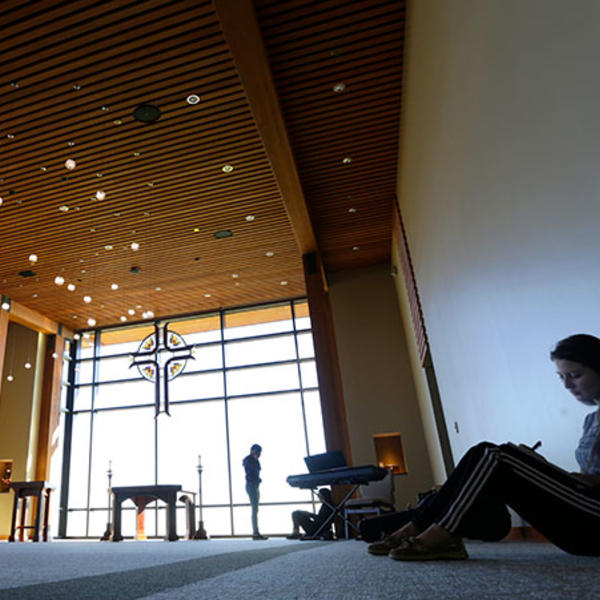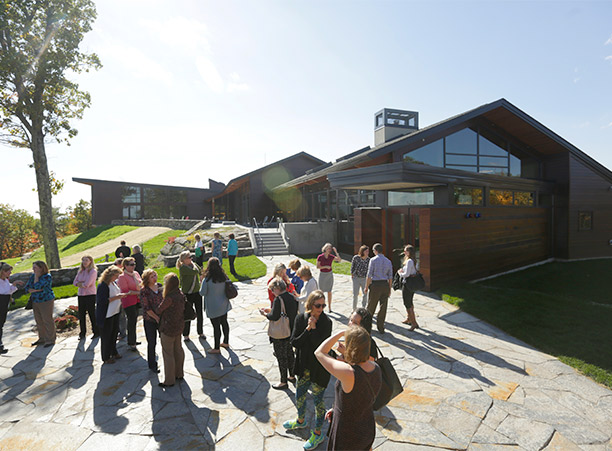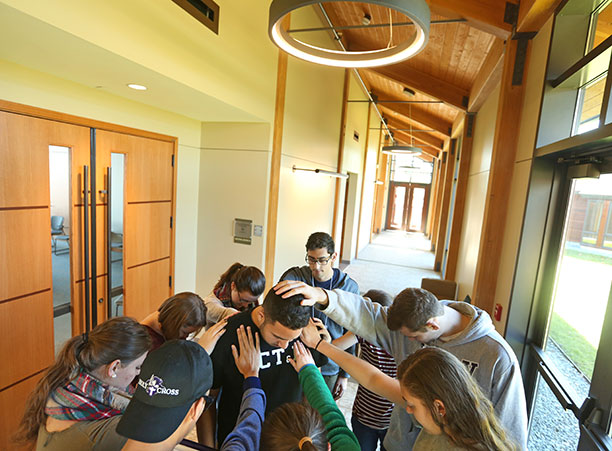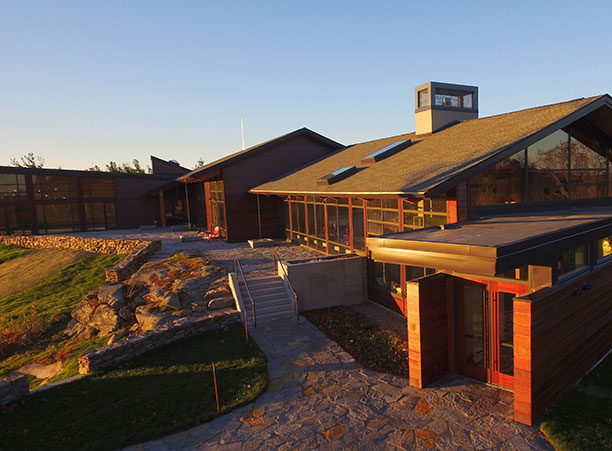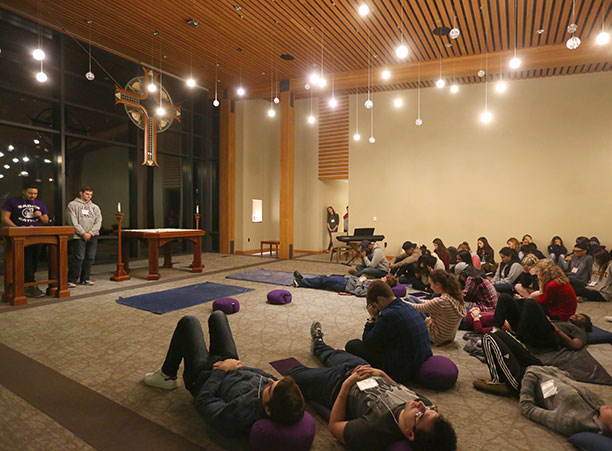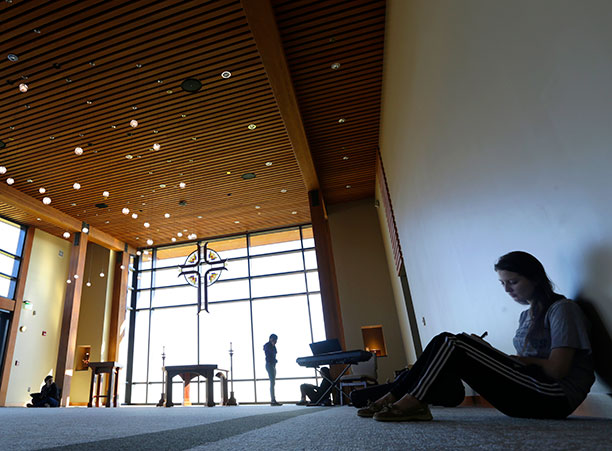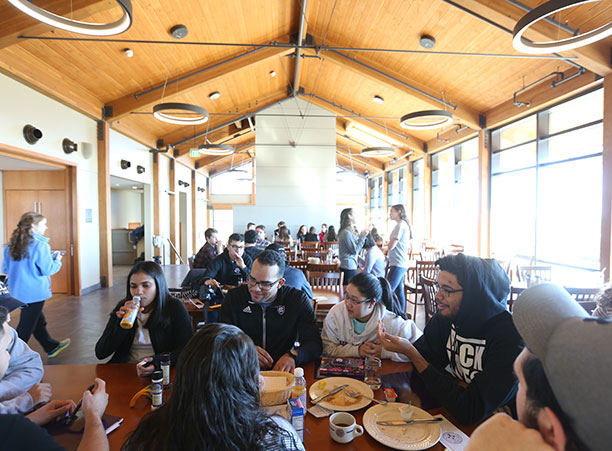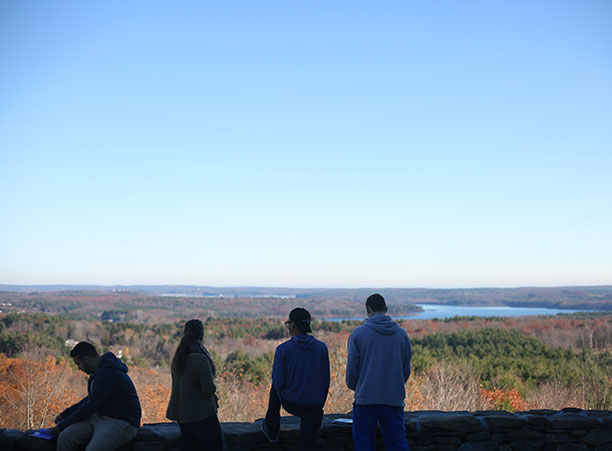There are plenty of beautiful, serene places to pray on campus at the College of the Holy Cross. There are three chapels here, in addition to Campion House, the home of the Office of the College Chaplains, and any number of picturesque outdoor spaces atop Mount Saint James.
But the newest space is just a few miles away from campus, at the top of a hill in West Boylston with a view of nearby Wachusett Reservoir and quintessential New England foliage as far as the eye can see. The Thomas P. Joyce ’59 Contemplative Center is a 33,800 square-foot complex featuring a chapel, meeting rooms, dining room, and bedrooms for 60 individuals in a lodge-like atmosphere removed from the regular bustle of campus life. Holy Cross students, alumni, faculty and staff can be found here year-round, spread out across the vast 52-acre site, reading in the quiet nooks, writing in the sprawling woods, or speaking with spiritual advisors.
“The Contemplative Center is a concrete symbol of what our Jesuit and Catholic tradition invites the members of our community to do,” says Rev. William R. Campbell, S.J., the College’s Vice President for Mission. “To be reflective, to step away and to think deeply and engage the issues in a space that’s conducive and has taken on a sacred character."
Since its opening in 2016, the Joyce Contemplative Center has become increasingly engrained in the Holy Cross experience. More than 700 students — roughly 25 percent of the student body — took part in a retreat or program at the Center during the 2016-17 academic year. A highlight is the Spiritual Exercises, a five-day silent retreat based on the Spiritual Exercises of St. Ignatius, which is offered four times a year. In May, students are invited to step away from the bustling campus for the “Eat, Pray, Study” retreat, where they can study for their upcoming finals in a quiet, serene atmosphere.
The Center is not just for students. Alumni visit for retreats, taking the opportunity to pray and reflect and reconnect with their fellow alumni and with God. Athletics teams and academic departments use the facility for team building that goes beyond X’s and O’s and the upcoming syllabus. The College’s Board of Trustees has also held a retreat here. Most weeks, the Chaplains' Office is juggling three or four programs, says Marybeth Kearns-Barrett, the Director of the Office of College Chaplains.
But it isn’t for every event, Kearns-Barrett is quick to point out. This isn’t just a meeting space or a well-appointed retreat house. Every event here should have at its core a contemplative, Ignatian purpose.
The architects of the Center, Lamoureux Pagano & Associates, Inc. of Worcester, were given the autobiography of St. Ignatius for inspiration, which is revealed in small touches throughout the property. Dozens of hanging pendant lights in the chapel mimic the night sky, which often held Ignatius’ gaze during his convalescence in Loyola, Spain.
The ceiling of the chapel is angled upward, just slightly, seeming to stretch upwards toward the sky. A stained-glass cross is suspended at the front, just before a glass wall that looks out over the surrounding beauty. It’s Kearns-Barrett’s favorite space on the property.
“That’s the place that reminds us of what this place is for, and why we’re there," she says.
The Center builds on an already full mission and ministry program at Holy Cross. Of the 2017 graduating class, 68 percent participated in a College ministry program through the Office of College Chaplains, among the highest rates of participation of all Catholic colleges in the country. And in recent years, more than 150 faculty and administrators have participated in a 12-day pilgrimage to the sites associated with St. Ignatius, St. Francis Xavier, and other early Jesuits as well as the wider Catholic Church in Spain and Rome, after having engaged in discussion seminars on relevant readings prior to each trip.
Though the Center is removed from the main College, there are echoes of campus everywhere. Black and white photography on the walls depict slices of spirituality found back on campus, each one echoing aspects of the Exercises. The suspended stained-glass cross in the chapel was built according to the same design by the same liturgical artist who built the crosses in chapels on campus.
And while those echoes are present, being removed from campus allows students to disconnect from the day-to-day, says Fr. Campbell. Cell phones are left at home or dropped in a basket at the door. The outside world beyond view is left behind.
Last fall, Fr. Campbell observed two students from Cleveland and Chicago, who attended a silent retreat at the Center. Fully immersed in the Spiritual Exercises, the pair, both avid baseball fans, had no idea that their respective teams were set to meet in the World Series.
“It’s nice to see how seriously the students take the invitation to step away,” Campbell says, “and focus on prayer.”
This article originally ran in the April issue of Connections, an online publication of the Associations of Jesuit Colleges and Universities.
Related Information
- Take a Look Inside the New Joyce Contemplative Center
- View and interact with 360/virtual reality images of various rooms in the Thomas P. Joyce '59 Contemplative Center.
